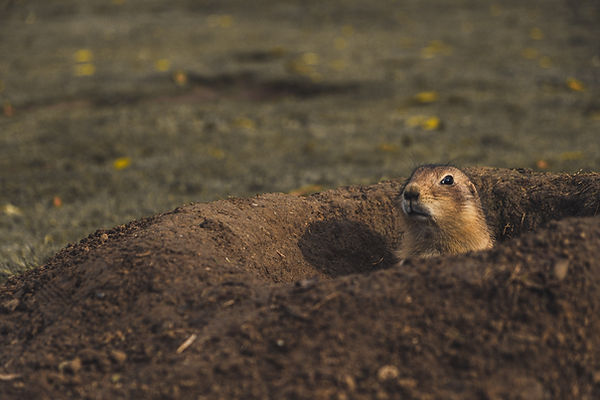Coexisting with Prairie Dogs

Often viewed as pests, prairie dogs are actually a keystone species that play a vital role in the short grass prairie ecosystem. They not only provide food for a vast amount of wildlife, including the critically endangered black footed ferret, but their tunnels provide shelter for other animals and allow rain water to enter underground aquafers. Explore the common concerns below and their best resolutions.
Concern #1 - Bubonic Plague
Resolution - Bubonic plague was purposely introduced into prairie dog colonies in 1915 in order to exterminate them. The plague still is prevalent in colonies today. Prairie dogs themselves do not carry the bacteria that causes the plague but rather the fleas that live on the prairie dogs do. When living close to prairie dog towns or enjoying natural areas that prairie dogs call home the best thing to do is keep pets on a leash and away from the burrows. Plague is most often transmitted to humans because a pet has picked up an infected flea and brought it into the home.
Concern #2 - Colony is getting close to home
Resolution - If the prairie dogs are getting a bit too close to your home the easiest way to encourage them to move along is to create visual barriers. Because prairie dogs are a food source for many predators, they prefer to live in areas where they can see a long distance away. By blocking their view, they feel unsafe and will be encouraged to move to a safer location. A vinyl fence, hay bales, trees, or shrubs all impede vision. Be aware that prairie dogs are known as nature's lawn mowers, so planting taller grasses may not be as effective as fencing.
If prairie dogs are taking up residence under your porch the same steps above can be utilized to encourage them to leave. Additionally, placing fake owls or other birds of prey within view can create a sense of danger for the prairie dogs. Most animals take up residence near our homes due to a sense of safety or food availability and if we can disrupt that they typically choose to leave.
Concern #3 - Cattle Range Overlap
Resolution - Perhaps the most common concern when it comes to prairie dogs are their potential impacts on cattle grazing. Prairie dogs evolved alongside the American Bison, and the short grass prairie can also support domestic cattle. Rotating livestock to different pastures depending on the season can help livestock owners coexist with prairie dogs. Though prairie dogs can reduce the amount of forage available for cattle, the forage within prairie dog colonies is significantly more nutritious than in areas without them.
Rotating cattle to different range can also help reduce the number of prairie dog colonies. Areas that are overgrazed can be inviting to prairie dogs because they are able to see further. By rotating livestock and allowing grasses to replenish it discourages prairie dogs from moving in.


